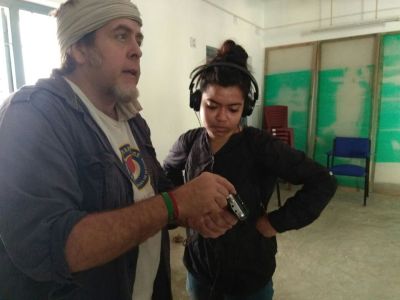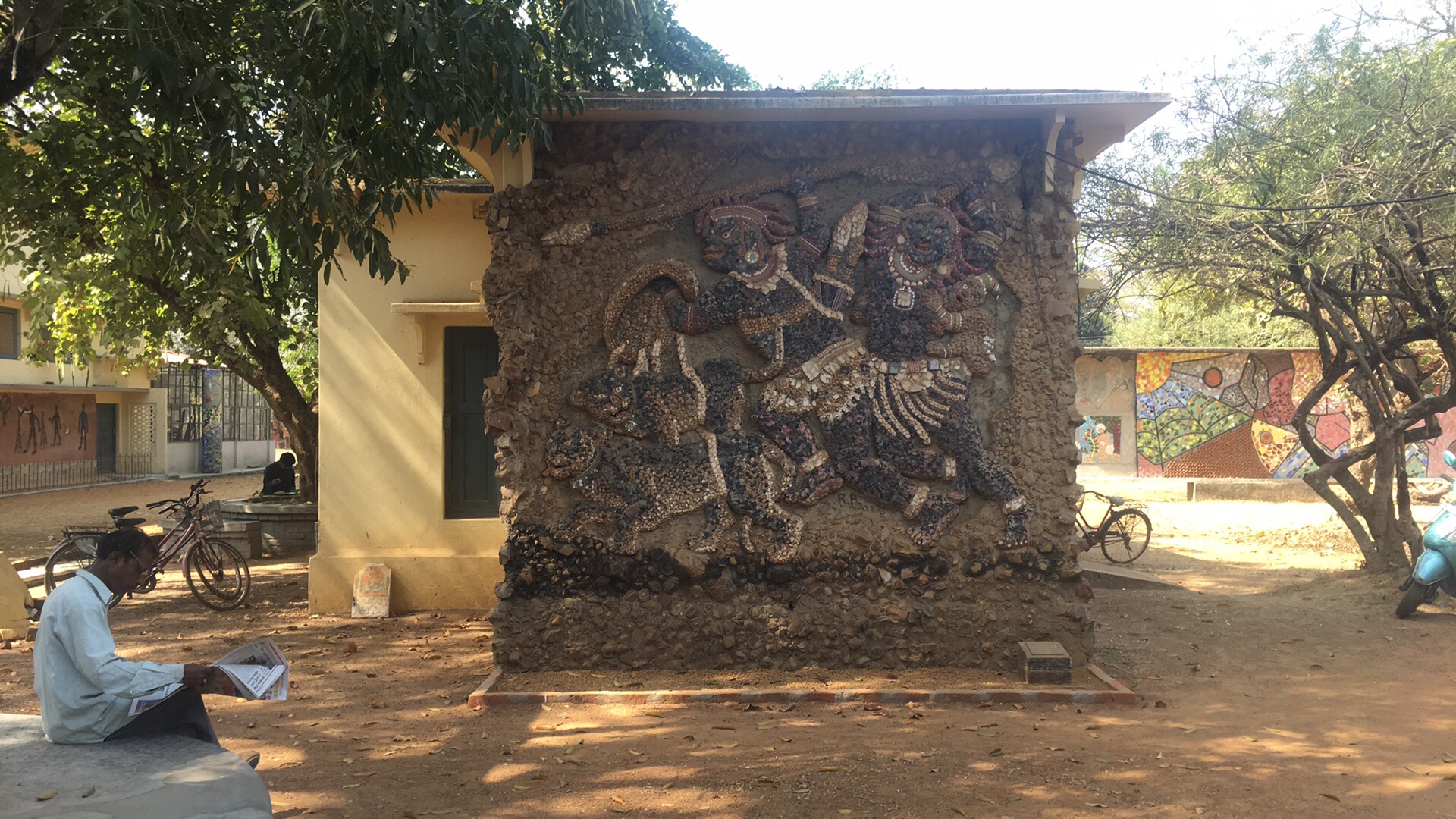
From February 5th until March 6th of 2018 I was involved with a presentation of sonic arts to the visual arts students of the Kala Bhavan art school of Visva Bharati, Santiniketan.
The program consisted of a series of LISTENING SESSIONS at the Nandan Gallery, as well as OPEN STUDIO SESSIONS at the Center of Interdisciplinary Arts. In the mean time, I explored the history of Santiniketan and the local region.

This sonic arts residency was the first of its kind at this iconic art school known for its historical relations with important Indian artists working in mural, sculpture, painting and graphic design, as well as for its spiritual relationship to the vision of Rabindranath Tagore. Initially, I was challenged by how to expand sound art beyond its technological boundaries and reach into a more essential, experiential space for listening and creating. I also wanted to demonstrate the connections between visual/tactile practices and sound-making, so important to my own work.
 Monday and Friday afternoons were my scheduled LISTENING SESSIONS at the NANDAN GALLERY. Here, with the help of some students, I organized my way of introducing deep or profound listening states.
Monday and Friday afternoons were my scheduled LISTENING SESSIONS at the NANDAN GALLERY. Here, with the help of some students, I organized my way of introducing deep or profound listening states.
We had a fascinating blend of students as well as local artists, ex-patriots, and other curious participants. Blindfolded, participants listened to distant sounds heard from the terrace and then were led individually into the gallery, where I explored my concept of ‘deconstructed classroom’ with organic materials spread across different carpets, cardboard and various other surfaces, making for a certain tactile ‘disorientation’ process to happen.
Finally, with the participants seated one-by-one, the listening event began with my own sound-work ‘Frozen Illuminations’ amplified in the gallery (speakers in each corner of the room – central speakers with higher frequencies in the middle). The assistant performers and I used different acoustic materials (paper, leaves, stone, ceramic, whistles, bells, sticks) to create gentle sounds around the listeners. Additional speakers played recordings and low-frequency pulsations. All of this created a field of sounds — complex, involved and multivalent.

My intent of this design was to facilitate a seamless transition for the participants into an intimate space of listening. Then each session would go through a play list of different composers such as (Eliane Radigue, Pauline Oliveros, Hitoshi Kojo, Yannick Dauby, Christoph Heemann, Zoviet France, Terry Riley, Charlemagne Palastine, Catherine Christer Hennix, Ashley Bellouin, David Hykes, Michael Prime, Rick Reed, Angus Maclise, Monos/Ora, Francisco Lopez, Loren Chasse, Delia Derbyshire), where I interacted as a vague curator of themes and trajectories of experience.

After each session we sat in a circle and participants shared their experiences. Many described surprising personal interior spaces that opened up and our circle became a place of idea generation as well as an opportunity for the students to take a break from routines and devote themselves to a time of reflection. From the feedback I received, I learned that many students were positively affected by the experience.
 Throughout the week at different times, the CIA ‘Center of Interdiscipinary Studies’ was available for OPEN STUDIO sessions. Here students who wanted to pursue more specific projects could come and encounter more hands-on experience.
Throughout the week at different times, the CIA ‘Center of Interdiscipinary Studies’ was available for OPEN STUDIO sessions. Here students who wanted to pursue more specific projects could come and encounter more hands-on experience.
This include d the exploration of found-objects for sounding surfaces, recordings of specific sounds (drawing, breathing, etc), individuals could experience making their own field recordings then listening to and re-editing their own recordings and an introduction to computer sound editing was made as well as also some basic overview of sound technologies.
d the exploration of found-objects for sounding surfaces, recordings of specific sounds (drawing, breathing, etc), individuals could experience making their own field recordings then listening to and re-editing their own recordings and an introduction to computer sound editing was made as well as also some basic overview of sound technologies. 
Some sessions that went deeper included working with existing room ambience – making impromptu experiments of accumulative room resonance ala ‘I am sitting in a room’ A.Lucier – where we recorded acoustic events, poetry and songs then played such recordings back into the empty studio while re-recording it again—each layer compounding existing resonances and bringing up mysterious frequencies out of the mix.
Along the same lines a controlled feed back situation was created where the room acoustics were explored as well through subtle filtering of the space. See video demonstration below.
Towards the end of the residency the work shifted to the apartment ‘Malancha’ or Garden house for more refined mixing and focus in a smaller space.
The final presentation on the morning of March 6th, 2018 on the campus of Kala Bhavan – was entitled:
Sonic ‘incense’ – a fluid-art interaction with morning ambience of the Kala Bhavana campus
Which consisted of a series of diffused sound works – interspersed with spoken word texts from Tagore and Jiddu Krishnamurti.
Four large speakers were placed on top of the ‘canteen’ which is a natural gathering place of the students for tea and food. These speakers were arranged in such a way as to strengthen the reflections of the sounds throughout the Kala Bhavan campus, as well the pieces that were played back were designed to explore the architectural interaction of this campus space itself.
Other speakers were placed in trees and near sculptures that were designed with the over-arching intent to create a complete sonic experiment, where the sound sources were invisible and the complete experience was a synthesis of sound woven to the site specific space.
 This was the first time that such a large scale sonic-art experience came to Kala Bhavan campus and therefore, I intentionally organized this to happen for three hours during breakfast time and before classes began – so all students would experience the works while they were getting ready for school, as well as the faculty, who sat under one of the trees having their morning tea. This was specifically designated to break with the common habit of viewing sound (music) as entertainment and a spectacle—the timing emphasized the sound as an integrated public art experience.
This was the first time that such a large scale sonic-art experience came to Kala Bhavan campus and therefore, I intentionally organized this to happen for three hours during breakfast time and before classes began – so all students would experience the works while they were getting ready for school, as well as the faculty, who sat under one of the trees having their morning tea. This was specifically designated to break with the common habit of viewing sound (music) as entertainment and a spectacle—the timing emphasized the sound as an integrated public art experience.
During this time Anudev M and his crew created a sonic-reading of the Mastermoshai wall paintings near by. The overall experience was a comprehensive and unified one with an over all feedback of attention, curiosity and understanding of the potential of sound to alter a usual and daily space, creating a fantastic new reading of what is normally an ordinary situation.
-
The program of works diffused that day – all generated from the residency:
- Whispers of Tagore / Meghdutta – Bflat as a tone-coloring the space & the presence of clouds
- Bugu Riza – “Breathing Kori-Mati” (student work)
- Sketches – SURFACES translated – with Anudev M
- Last day of the Fire-Rooster Year – controlled feedback of the CIA studio
- Dakini’s of the Center of Interdisciplinary Arts Room – exploration of accumulated resonance
Here is a collection of these tracks and others recently produced at Amnesia Studios in Kolkata.

OTHER events –
“Sonic Photogrammetry” – A Performance Poetry around Mastermoshai studio – Anudev M & Seethal C P (see a blog post about my residency by Seethal here)
“cyclical intergrating point” – Sonic interpretation of the sculptural space of Nitish Kumar
Overall this residency – throughout all of the challenges – was a fantastic success – and shows the potency of sound as an involving and exciting medium to be explored by a new generation of young Indian artists. I also have learned a lot about how sound also can be involved in relationship to other practices. I look forward to other opportunities as well as re-working the potential of sonic-arts studies to other contexts. Specifically deepening the pedagogical approach of LISTENING in general – as well as reflections on what other sonic arts programs goals could expand to – including practice of sound-design for web, video, installation and performance art – with a more devoted program with regular classroom sessions as the development of sound-as-art is a project that take time to develop – it is not something that quickly can be ‘understood’ – rather it is a practice to be developed.


